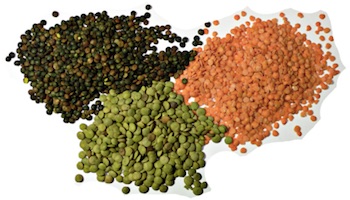Science of Cooking with Lentils
GENERAL INFORMATION ON LENTILS
Lentils, the humble legumes that have been a staple in cuisines around the world for centuries, are a true powerhouse of nutrition and versatility. These small, lens-shaped seeds are not only affordable and readily available.
What sets lentils apart is their ability to adapt to a wide range of culinary preparations. From hearty soups and stews to salads, curries, and even burgers, lentils add a hearty and nutritious element to countless dishes. They have a mild, earthy flavor that blends well with various spices and ingredients, making them a versatile ingredient in vegetarian and vegan cooking.
Lentils exist as a spectrum of colors, which includes yellow, orange, red, green, brown or black, depending on the cultivar, the composition of the seed coats and cotyledons..

See: \ Phenolic substance characterization and chemical and cell-based antioxidant activities of 11 lentils grown in the Northern United States for more information.
HEALTH BENEFITS OF LENTILS
There has been increasing scientific interest in the study area of lentils as the functional food due to its high nutritive value, polyphenols, and other bioactive compounds.
Lentils are a nutritious legume that offer several health benefits. Here are some of the key health benefits associated with consuming lentils:
1-Rich in essential nutrients: Lentils are packed with essential nutrients, including dietary fiber, protein, folate, iron, potassium, magnesium, and vitamins B1 and B6. These nutrients are important for overall health and well-being.
2-High in dietary fiber: Lentils are an excellent source of dietary fiber, both soluble and insoluble. Fiber aids in digestion, helps regulate blood sugar levels, promotes heart health, and supports healthy weight management. It also helps maintain bowel regularity and prevents constipation.
3-Heart-healthy: The soluble fiber found in lentils can help lower cholesterol levels, thus reducing the risk of heart disease and stroke. Lentils are also low in fat and sodium, making them a heart-healthy food choice.
4-Blood sugar control: The high fiber and low glycemic index of lentils contribute to better blood sugar control. They slow down the digestion and absorption of carbohydrates, preventing spikes in blood sugar levels. This makes lentils a beneficial food for individuals with diabetes or those at risk of developing it.
5-Weight management: Lentils are low in calories and high in fiber and protein, which can help promote satiety and reduce overall calorie intake. Including lentils in your diet may help with weight management and prevent overeating.
6-Digestive health: The fiber content in lentils supports a healthy digestive system by promoting regular bowel movements, preventing constipation, and providing fuel for beneficial gut bacteria. This can contribute to improved gut health and overall digestive well-being.
7-Nutritional support during pregnancy: Lentils are an excellent source of folate (vitamin B9), a crucial nutrient for pregnant women. Adequate folate intake helps prevent neural tube defects in infants and supports proper development during pregnancy.
8-Protein source for vegetarians and vegans: Lentils are a rich source of plant-based protein, making them an excellent choice for individuals following vegetarian or vegan diets. Protein is essential for building and repairing tissues, supporting muscle health, and maintaining overall bodily functions.
9-Anti-inflammatory properties: Lentils contain various phytochemicals and antioxidants that have anti-inflammatory properties. These compounds help reduce inflammation in the body and may contribute to the prevention of chronic diseases like heart disease, diabetes, and certain types of cancer.
COMBINING LENTILS WITH KALE FOR A SUPER FOOD
Kale contain numerous micronutrients, such as antioxidants, carotenoids, glucosinolates, polyphenols, vitamins, and minerals important to human health. Eating Kale and Lentils together gives an added boost make it a super food. See article below

Image above: Seared Salmon with Lentils and Kale
Lentil and Kale: Complementary Nutrient-Rich Whole Food Sources to Combat Micronutrient and Calorie Malnutrition See source.
SOME BIOACTIVE MOLECULES IN LENTILS
 Quercetin-3-O-glucoside
Quercetin-3-O-glucoside
 Catechin
Catechin
 Epigallocatechin
Epigallocatechin
See Polyphenol-Rich Lentils and Their Health Promoting Effects -- for full list of bioactive compounds
Science of Cooking
See also:
- How can dried Shitake mushrooms be more flavorful than fresh mushrooms
- Adding Flavor by using Umami
- Artificial Sweeteners
- Science of Culinary Foams
- Food Thickening Agents
- What is Sous Vide Cooking
- What are Polysaccharides?
- Xanthan Gum
- Guar Gum vs. Locust Bean Gum
- Agar Molecular Properties in Cooking
- Pectin
- Science of Hydrocolloids in Cooking
Health Risks in Cooking
- What are Trans Fats?
- What is lactose intolerance?
- What is the difference between LDL and HDL?
- What are the different types of Omega-3 fatty acids?
- What is the difference between nitrates and nitrites?
- What is the difference between saturated and unsaturated fats?
- Why is Carbon Monoxide used in meat and fish?
- All about gluten sensitivity and issues with lectins